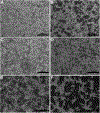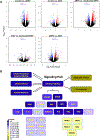Isolation of a novel insect-specific flavivirus with immunomodulatory effects in vertebrate systems
- PMID: 34256244
- PMCID: PMC8419152
- DOI: 10.1016/j.virol.2021.07.004
Isolation of a novel insect-specific flavivirus with immunomodulatory effects in vertebrate systems
Abstract
We describe the isolation and characterization of a novel insect-specific flavivirus (ISFV), tentatively named Aripo virus (ARPV), that was isolated from Psorophora albipes mosquitoes collected in Trinidad. The ARPV genome was determined and phylogenetic analyses showed that it is a dual host associated ISFV, and clusters with the main mosquito-borne flaviviruses. ARPV antigen was significantly cross-reactive with Japanese encephalitis virus serogroup antisera, with significant cross-reactivity to Ilheus and West Nile virus (WNV). Results suggest that ARPV replication is limited to mosquitoes, as it did not replicate in the sandfly, culicoides or vertebrate cell lines tested. We also demonstrated that ARPV is endocytosed into vertebrate cells and is highly immunomodulatory, producing a robust innate immune response despite its inability to replicate in vertebrate systems. We show that prior infection or coinfection with ARPV limits WNV-induced disease in mouse models, likely the result of a robust ARPV-induced type I interferon response.
Keywords: Aripo virus; Flavivirus infection; Flavivirus pathogenesis; Insect-specific flavivirus; Super-infection exclusion; West nile virus.
Published by Elsevier Inc.
Conflict of interest statement
Declaration of interests
The authors declare that they have no known competing financial interests or personal relationships that could have appeared to influence the work reported in this paper.
Figures






References
-
- Adam A, Luo H, Osman SR, Wang B, Roundy CM, Auguste AJ, Plante KS, Peng BH, Thangamani S, Frolova EI, Frolov I, Weaver SC, Wang T, 2021. Optimized production and immunogenicity of an insect virus-based chikungunya virus candidate vaccine in cell culture and animal models. Emerg Microbes Infect 10, 305–316. - PMC - PubMed
-
- An SY, Liu JS, Ren Y, Wang ZS, Han Y, Ding J, Guo JQ, 2012. [Isolation of the Culex flavivirus from mosquitoes in Liaoning Province, China]. Bing Du Xue Bao 28, 511–516. - PubMed
-
- Arnold K, Bordoli L, Kopp J, Schwede T, 2006. The SWISS-MODEL workspace: a web-based environment for protein structure homology modelling. Bioinformatics 22, 195–201. - PubMed
Publication types
MeSH terms
Substances
Grants and funding
LinkOut - more resources
Full Text Sources

